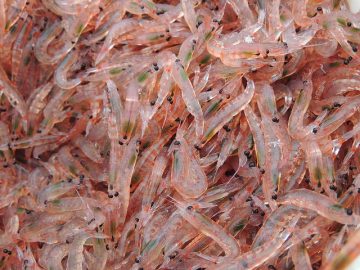In response to warming climates, Antarctic krill are moving south to colder regions, a new study finds.
Using data from the KRILLBASE Project, scientists investigated how the Antarctic krill population in the Southwest Atlantic Sector is changing. Most Antarctic krill were once found in the northern part of this region. However, over the last 90 years, the krill population has declined sharply in the north and has moved southward in response to rapid regional warming. Now the population is more heavily concentrated around the colder, southern Antarctic ice shelves.
Antarctic krill are a keystone species; meaning that they play a crucial role in their ecosystem. As an important intermediate, krill connect many predators like fur seals, birds and whales with tiny creatures. By performing this important ecosystem service, krill also greatly influence the cycle of critical elements such as carbon, nitrogen and iron by returning these elements to the environment.
“It has long been believed that Antarctic krill are a cornerstone of the Antarctic ecosystem and are currently the most harvested species in the region,” said Dr. Evgeny Pakhomov, the Director of UBC’s Institute for the Oceans and Fisheries and a biological oceanographer, who is a co-author of the study. “Krill’s enormous biomass is perhaps the largest, yet not heavily tapped, fishing resource in the world’s oceans.”

Dr. Evgeny Pakhomov
The researchers found that one major factor impacting the krill population was the Southern Annular Mode (SAM). The SAM is a pattern of winds that greatly influences various aspects of the Antarctic climate such as wind intensity, temperature and rainfall. It indirectly affects krill population dynamics by influencing the number of juvenile krill recruiting – or joining – the population each year.
Antarctic krill are a cornerstone of the Antarctic ecosystem and are currently the most harvested species in the region
Over the years, the typical SAM pattern, which is influenced by global weather patterns, has shown increasingly more abnormalities that have led to warmer, windier and more cloudy weather, with reduced sea ice conditions. This combination of factors negatively affect krill, which need sea ice to spawn, and, more importantly, need ice to help their young survive through the winter. In the years following such abnormalities, there are usually a lower number of juvenile krill, leading to a population decline. However, after several years of poor recruitment, there is typically one or two years of good recruitment when many small, young krill join the population, boosting overall numbers.
Interestingly, the researchers also found that the total population density of krill has declined less steeply than the density of recruits. This means that the total number krill in the area is decreasing more slowly than the number of juvenile krill, which suggests that older krill are dying less often or that they live longer, or both.

Krill
Photo credit: KoiQuestion /Flickr
The changing krill population and regional warming are expected to have major impacts on the Antarctic environment. For example, as the krill population contracts and increasingly concentrates around the ice shelves in response to warming, krill may become linked to new predators and alter biogeochemical cycling in the region.
“It is true that the recruitment frequency, which used to be more regular, has declined in recent decades,” said Pakhomov. “Moreover, in the southern parts of the region, we now see larger adults that likely live longer, but we do not yet know how this will affect the pelagic ecosystem structure, Southern Ocean biogeochemistry and relaying on krill top predators.”
The paper “Krill (Euphausia superba) distribution contracts southward during rapid regional warming” was published in the journal Nature Climate Change.
Tags: Antarctic, Evgeny Pakhomov, faculty, krill, oceanography, Research, species distribution